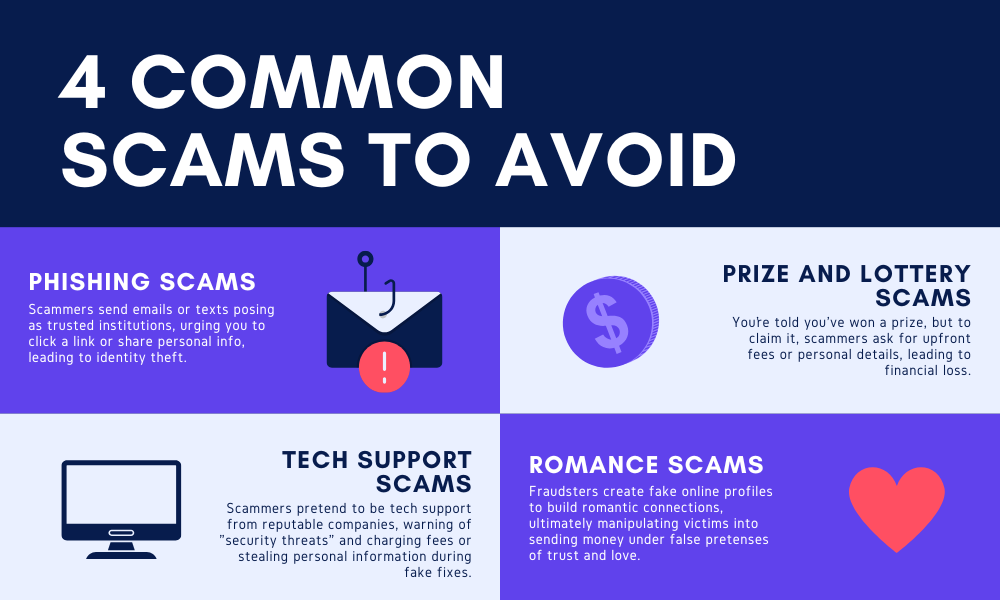Practical Cybersecurity Tips: How You Can Help Keep Your Members Safe
In today’s digital age, cybersecurity is a top priority for financial institutions, especially credit unions dedicated to protecting their members' personal and financial information. Here’s how your credit union can implement effective cybersecurity practices to help keep members safe.
Download Now: FLEX's Security Services eGuide

8 Tips for Encouraging Member Cybersecurity
1. Educate Members on Recognizing Cyber Threats
One of the most effective defenses against cyber threats is a well-informed member base. By educating your members on recognizing phishing attempts, secure browsing practices, and common fraud tactics, you empower them to be the first line of defense.
- Host webinars covering current cyber threats and preventative strategies.
- Send regular security tips through email, mobile app notifications, and social media.
- Create guides or infographics that explain common scams and security practices. Refer to the example below to get started.

2. Encourage Multi-Factor Authentication (MFA) Use
Multi-factor authentication adds an additional layer of security to members’ accounts by requiring two or more verification steps. This minimizes the risk of unauthorized access, even if a password is compromised.
- Offer biometric options like fingerprint or facial recognition for mobile banking.
- Educate members on the importance of MFA and guide them through enabling it in your mobile and online platforms.
.png?width=492&height=204&name=You%E2%80%99re%20told%20youve%20won%20a%20prize%2c%20but%20to%20claim%20it%2c%20scammers%20ask%20for%20upfront%20fees%20or%20personal%20details%2c%20leading%20to%20financial%20loss.%20(1).png) Source: Microsoft
Source: Microsoft
3. Utilize Advanced Fraud Detection Systems
Fraud detection systems analyze behavior and flag unusual patterns that may indicate fraud. These systems alert both your credit union and your members in real time, providing a proactive response to potential threats.
- Implement AI-powered fraud detection tools for continuous monitoring.
- Alert members immediately of any suspicious activity, allowing them to verify or deny transactions.
4. Encrypt Sensitive Data End-to-End
Encryption scrambles data into unreadable text, making it almost impossible to decipher without the right key. Protecting member data through encryption provides an essential layer of security.
- Encrypt data at every stage—during storage, transmission, and when it’s being accessed.
- Use end-to-end encryption for secure communication and data transfers within mobile and online banking apps.
.png?width=378&height=496&name=You%E2%80%99re%20told%20youve%20won%20a%20prize%2c%20but%20to%20claim%20it%2c%20scammers%20ask%20for%20upfront%20fees%20or%20personal%20details%2c%20leading%20to%20financial%20loss.%20(3).png)
5. Regularly Update Software and Systems
Outdated software can expose vulnerabilities that hackers exploit. Keeping systems updated protects your credit union and its members from evolving cyber threats.
- Schedule regular software updates and prompt employees to stay on top of updates.
- Encourage members to keep their apps up to date for enhanced security.
.png?width=460&height=261&name=You%E2%80%99re%20told%20youve%20won%20a%20prize%2c%20but%20to%20claim%20it%2c%20scammers%20ask%20for%20upfront%20fees%20or%20personal%20details%2c%20leading%20to%20financial%20loss.%20(4).png)
6. Back Up Data and Develop a Recovery Plan
Regular data backups and a clear recovery plan are crucial for minimizing the impact of a cyber incident. This way, you can quickly restore lost or compromised data, ensuring minimal disruption for members.
- Back up all data frequently, including transaction records and member information.
- Store backups in secure, offsite locations to prevent data loss in case of a breach.
7. Promote Secure Password Hygiene
Strong passwords are essential for account security. Encourage members to create unique, complex passwords and to avoid reusing passwords across different accounts.
- Share password creation tips with members, such as using a mix of letters, numbers, and symbols.
- Encourage regular password changes and the use of password managers for easy management.
.png?width=435&height=442&name=You%E2%80%99re%20told%20youve%20won%20a%20prize%2c%20but%20to%20claim%20it%2c%20scammers%20ask%20for%20upfront%20fees%20or%20personal%20details%2c%20leading%20to%20financial%20loss.%20(5).png)
8. Utilize Secure Communication Channels
Ensuring that communication channels are secure helps members feel confident about reaching out to your credit union for assistance. By providing secure options, you mitigate the risk of sensitive data being intercepted.
- Encourage members to use in-app messaging or other secure communication channels.
- Advise against sharing sensitive information over social media or unsecured email.
Build a Cyber-Safe Credit Union Community
By implementing these cybersecurity practices, your credit union can foster a safer digital experience, ultimately building trust and strengthening member relationships.
However, ensuring your members' safety from cybersecurity threats is ineffective without proper security measures at the credit union. At FLEX, we offer integrated and third-party solutions to effortlessly assist your credit union in combating cybercriminals.
Click the button below to learn more about FLEX's security services.



